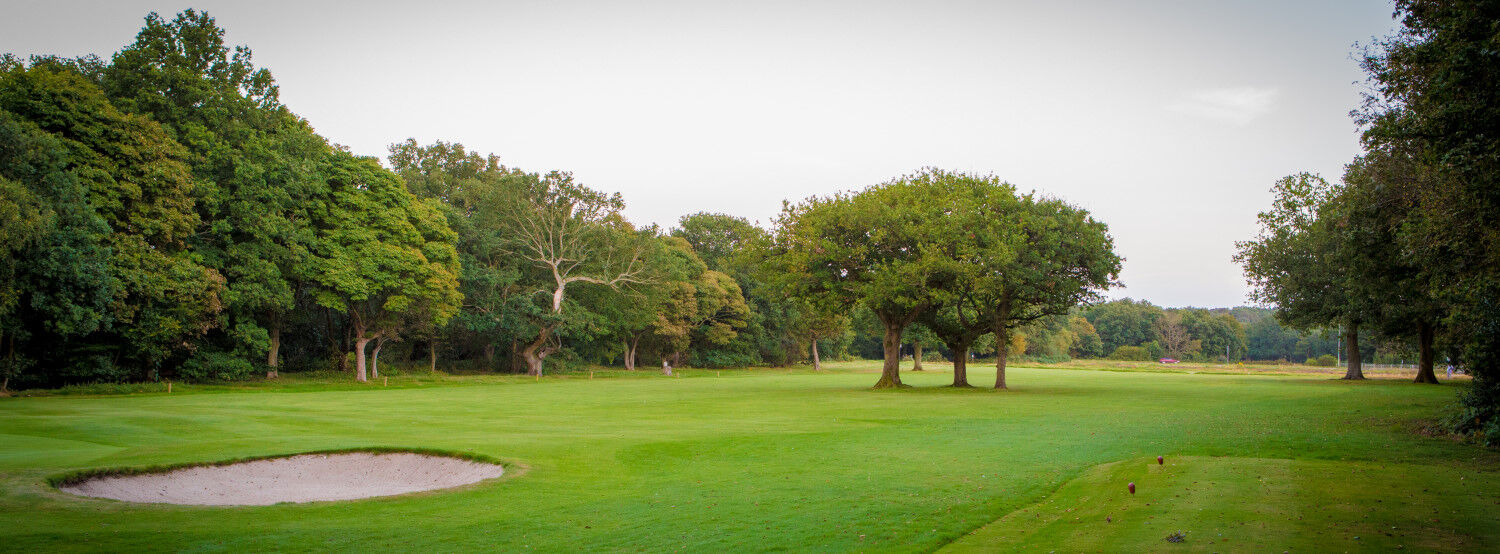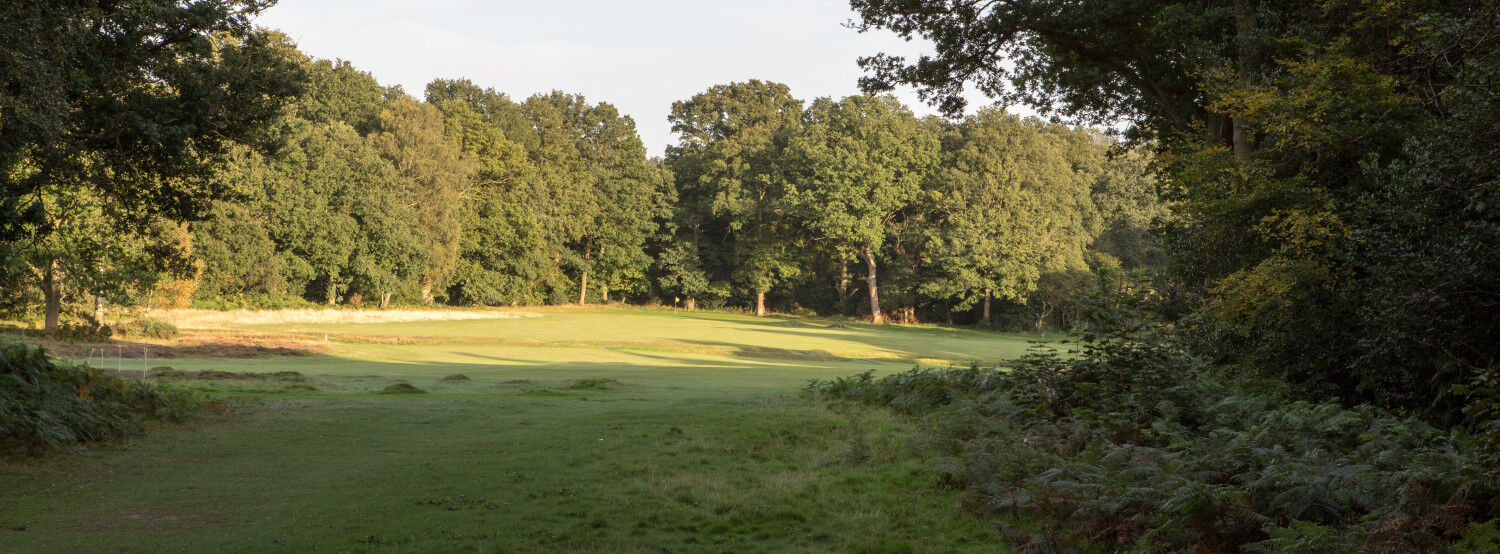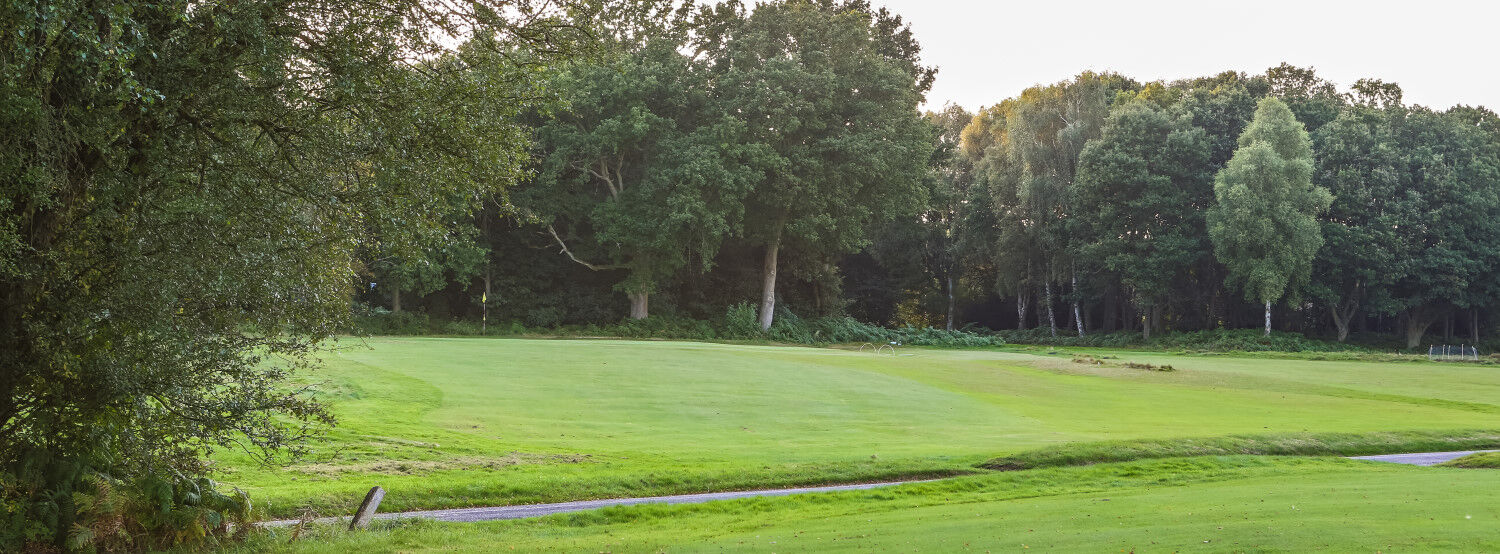World War 1
THE STORIES BEHIND THE NAMES
100 years ago the Somme battle was already in its fourth month. Exactly half the 20 names here inscribed were already dead, the others still to come. This memorial has a simplicity of statement. You can see at once that what is recorded is both important and significant, and should make you want to know more. I will help that journey now by telling you about some of the names and what they tell us of the club at the time. I have also provided in these frames details about all of them.
When the war broke out in 1914, Limpsfield Chart Golf Club was already 25 years old, one of the earliest clubs to be formed in England amid an explosion of golf worldwide. You are in distinguished company – in 1889 were also founded Royal Birkdale, Royal County Down in NI, and further afield Royal Hong Kong. Limpsfield Chart GC flourished within the local community, and beyond. The membership list filled very quickly and had to be restricted to 100, with a waiting list. By 1910 there were already 35 lady members, while the Gresham Artisan Golf Club, founded in 1908, widened the availability of golf well beyond the upper middle class and provided welcome assistance with course maintenance. Relationships between the Gresham and the Club were cordial with an annual match between them every Boxing Day. The support and influence of the Leveson Gower family meant that knowledge of the club spread well beyond the area. We are told that ‘horse-drawn carriages would meet golfers arriving at Oxted station from London’. Eminent professional and amateur golfers extolled the virtues of the course and played exhibition matches on it. This was a significant local institution.
It is a disappointment that so little seems to have survived of the early records of the club, such as membership lists, account books, committee minutes and any evidence about the origins of this memorial. The Gresham seems to have a similar void in its history. There are some things therefore that I cannot tell you – when this memorial was dedicated, how long these names had been members here or how well they played golf. It is also difficult to know how they reflected the age range or social balance of the club, but in researching these 20 names there is much that is fascinating.
Firstly all but one lived in this area for at least some of their lives – 16 of the 20 in Oxted or Limpsfield, the others in Edenbridge and Hartfield. They were all young men – only four of them over the age of 30. Twelve of them are aged 25 or younger, with the two youngest only 19. It is in that cutting-off of youthful promise, that tantalising glimpse of what might have been for so many young men, that the true tragedy of the war lies. All but two were junior army or Royal Flying Corps officers (2nd Lt, Lt and Capt) who suffered the proportionately highest casualty rate of any ranks in the war. It is worth reflecting briefly on the role of these junior officers. As young as 18 years old and commanding platoons of 30 or more older men, they were expected to be first over the top in any attack, and set examples of courage, endurance and, if necessary, sacrifice. One senior officer noted this awesome burden of responsibility: ‘I have seen boys fresh from school in whose faces there were two personalities expressed: the one full of the light-hearted, irresponsible vitality of boyhood, and the other scarred with the anxious lines of one to whom two hundred exhausted nerve-shattered men have looked, and not looked in vain, for leadership and strength in their grim extremity’.
They are clearly all from the wealthier classes, which I would assume was the overwhelming social composition of the club at that time. There appears to be no war memorial for the Gresham, whose members must also have died. Most of these men went to major public schools - 3 to Eton, 2 to Winchester and 1 each to Charterhouse, Harrow, Tonbridge, Rugby, Radley, Westminster, Marlborough and Wellington. I came across a nice reflection on an Eton education from FM Lord Plumer, who was at Eton in the 1870s and became a WW1 general. He expressed the view that the style of education was more important than the content, when he said in 1916: ‘We are often told that they taught us nothing at Eton. It may be so, but I think they taught it very well’.
I have summarised their lives and deaths in these frames, but I cannot speak of them all and have selected four broad themes. Firstly, and most fittingly, given the family’s part in the founding of this golf club, there are the Leveson Gowers. Granville William Leveson Gower, Lord of the Manor of Titsey was the first President of this golf club, which was built on his land. When he died in 1895, his son Granville Charles took over the estate and the title and was President of the club for 37 years from 1912-49. It was a paternalism which the area has sadly lost. Many personal friends and wider members of the family must have come down at the weekend to stay at Titsey and play golf. For instance Henry Hammond Chambers, related by marriage to the Leveson Gowers, lived in London and was a barrister and former Captain of Cambridge University Golf Club.
The war struck home at Titsey very early in August 1914. Everard Smith was the son of the Rector of Titsey, the church virtually a private chapel to the estate. He was brought up on the estate, going to Hazelwood and then on to Winchester before embarking on a career in the Army. When war broke out his battalion, the 4th Royal Fusiliers, was one of the first to cross to France and he became one of the first casualties of the war. On 23 August 1914 he was defending the canal at Mons against overwhelming numbers of Germans when he was killed. His servant wrote to the family that ‘Lt Smith picked off eight Germans in succession before falling back wounded. He lived but a few moments saying to me ‘Carry on Goss’ before dropping his head and dying. He was a good officer and a gentleman who always had the goodwill of the men under his command.’ The second man on this board to die was also a regular army officer, Ralph Eyre Tanner, whose wife was eight months pregnant when war broke out. Tanner was to die of wounds in September 1914, ten days after his son was born – Peter who went on to become a famous film editor in Britain and in Hollywood, responsible for great films like ‘The Cruel Sea’ and ‘Kind Hearts and Coronets’.
Few families were left unscathed by the war and in 1917 it was the turn of the Leveson Gowers. Granville Charles’ second son Ronald left Eton in summer 1914 and was commissioned as an officer within two weeks of the war breaking out. He was badly wounded in September 1915 and spent 18 months recovering before rejoining his regiment, the Coldstream Guards, in 1917. He was badly wounded again in the opening stages of the Third Battle of Ypres in July 1917 and died of these wounds aged only 21. One of the tragedies of the war is the large number of young men like him who passed straight from the classroom to the battlefield and knew nothing else of life.
Secondly the royal connection. Malcolm and Edgar Gibson were the sons of Sir Walter Gibson, Secretary of the Privy Purse to Queen Victoria, Edward VII and George V – the royal official responsible for the financial management of the royal household. They lived at The Croft, Quarry Road, Oxted. Malcolm was killed at Loos in October 1915 aged 23, his brother Edgar only 19 in a plane accident while training to become a pilot in the RFC. There is a lovely stained glass window to their memory at St Mary’s in Oxted.
Patrick Bowes-Lyon lived at Skeynes Park in Edenbridge. He was the son of the Earl of Strathmore and uncle to HM Queen Elizabeth the Queen Mother. He gave the Bowes-Lyon Challenge Cup in 1938 for foursomes match play, the year he was captain of the club. He was also a fine tennis player, Scottish champion from 1885-8 and winner of the Wimbledon mens’ doubles in 1887. His elder son Gavin left Eton in 1914, an exact contemporary of Ronald Leveson Gower and was posted missing presumed killed at Cambrai in November 1917 aged 21 serving with the Grenadier Guards.
There is a postscript to this Bowes-Lyon story which not only highlights the terrible tragedies families had to live through in those days, but also shows the torments endured by survivors of the fighting. ‘Survived’ is a qualified word for the war must have had a lasting impact on all who fought – physical pain for those 1.5m carrying wounds, and mental traumas for most others who had fought in the front line. There was no counselling available then and I have come across many stories of tragic failure to cope with the post-war world.
Angus, the younger and only surviving son of Patrick Bowes Lyon, survived the fierce fighting of 1917-18 and witnessed many terrible sights. Readjusting to civilian life after the war was difficult for these young men, with many feeling guilty that they had survived when so many of their friends had not. In 1923 Angus shot himself, aged just 23. It was said at the inquest that the cause was his fiancé breaking off their engagement but I would be willing to hazard a guess that the strains of war contributed. Young men at the front lived at the edge of life and death. ‘Death,’ wrote one, ‘is such a frail barrier out here that we cross it, smiling and gallant, every day.’
Thirdly there is the football connection in the Bambridge brothers, Rupert and Frederick. The family lived at 9 Cecil Lodge, Gresham Road, Limpsfield. Their father Charles was a Lloyds underwriter. More importantly ‘Charlie Bam’, as he was known, had been one of the most famous footballers of his day in an age when amateurs still dominated the game – playing for the Corinthians and 18 times for England between 1879 and 1887, captaining them twice and scoring 11 goals in those 18 appearances as a fast winger, a pretty good scoring rate we could use now.
Rupert and Frederick Bambridge played golf here as young men, as probably did their father. They volunteered on the outbreak of war like most on this board. They joined the 10th Royal Fusiliers, one of the ‘Pals battalions’ of like-minded young men joining up to serve together. 10 RF was known as the ‘Stockbrokers Battalion’, its volunteers drawn from the City. They took the oath of attestation in the moat of the Tower of London on 29 August 1914, incidentally this being the inspiration for the poppy display at the Tower in 2014. Frederick was killed on the Somme in July 1916, his brother serving alongside him. Rupert had a hugely distinguished war. He won the MM in early 1916 as a sergeant, was commissioned in the field as an officer, won the MC for leading a trench raid in Nov 1916, another MC in Nov 1917 and the DSO in May 1918. Very few who served in the war had a collection of gallantry medals to compare with this. In May 1918 he died of wounds as a result of a German gas shell bombardment. ‘Dim through the misty panes and thick green light, as under a green sea, I saw him drowning. In all my dreams before my helpless sight, he plunges at me, guttering, choking, drowning.’ Wilfred Owen.
Finally there is Geoffrey Cather. It is a very remarkable honour for this club to have the holder of a Victoria Cross among its past members and named on its war memorial. The Victoria Cross was instituted by Queen Victoria in 1856 during the Crimean War and, in 160 years since then, only 1358 have been awarded.
Geoffrey St George Shillington Cather was born in October 1890, the elder son of Robert and Margaret Cather. Robert was a partner in Joseph Tetley and Co, tea merchants in Fenchurch Street, London. The family moved to Limpsfield sometime in the 1890s, and lived in Red Roofs, Bluehouse Lane. He went to Hazelwood School in 1900 and then to Rugby School, which he left in 1908 on the death of his father. Geoffrey Cather himself joined Tetley’s in London in 1908 as a tea buyer's assistant. He worked for them for a time in the USA before returning to England in 1914. When war broke out, he chose to go back to his Ulster family roots in Portadown, so he was commissioned in May 1915 in the 9th Battalion Royal Irish Fusiliers.
On 1st July 1916, the opening day of the Somme battle, Cather’s battalion was part of the 36th Ulster Division’s assault on the Thiepval Ridge. The first wave left the trenches at zero hour but came under intense machine gun fire, which also decimated the following waves. By nightfall nine officers and 235 men had been killed or wounded out of about 700.
Cather, the battalion adjutant, did not take part in the initial assault but could hear the cries of the wounded out in no man’s land and near the German wire. As evening fell he filled some water bottles and crawled out to help them, dragging or carrying many of the wounded to where the stretcher bearers could pick them up. There was heavy German artillery and machine gun fire throughout the four hours in which he was carrying out this work. The next morning he went out again in full view of the enemy trenches to help more of the wounded in no man’s land until he was killed by machine gun fire. His Victoria Cross was gazetted in September 1916, the citation stressing ‘his conspicuous bravery and self-sacrifice’. Cather’s body disappeared in the carnage on Thiepval Ridge, but he is commemorated on the Thiepval Memorial to the Missing, as well as on war memorials at Hazelwood, Rugby and here in Limpsfield, although, of local memorials, only the Hazelwood one records his VC, which is in the museum of the Royal Irish Fusiliers in Armagh, NI.
There is much that is lost in the mists of time. How did these 20 young men come to be elected to this club and what did they contribute to it on the golf course? How many club members fought in the war and survived? How did the older men and women members cope with the loss of their young? Who was the driving force in the commissioning of this memorial – a proud club member or grief-stricken parent? Gavin Bowes-Lyon’s papers at the National Archives contain a note from his distraught mother desperately seeking news of whether he had really been killed. Our generation has not had to suffer like our father’s and grandfather’s.
Institutions should cherish their history. The Roman author Cicero wrote: ‘to be ignorant of what occurred before you were born is to remain always a child’. For you here today the past is not another country inhabited by unknown people. The Limpsfield Great War generation may be separated from you by a hundred years of history, but you share much with them, playing the same course, chatting in the same clubhouse, giving a home to their names on this memorial. All that Great War generation has now gone but they were yours as young men and their names here should be a proud part of your history and heritage.
Extracts of a talk given by David Walsh at LCGC clubhouse, 16th October 2016
GW









